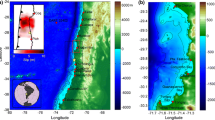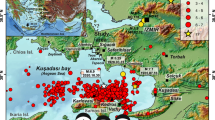Abstract
At 12:02:56 a.m. Monday, November 14 2016 NZDT (11:02:56 a.m., November 13 2016 UTC) a magnitude 7.8 earthquake struck near Kaikōura on the north-eastern coast of the South Island of New Zealand. This earthquake caused a tsunami along New Zealand’s east coast that was recorded on a number of sea level gauges. Outside of the Kaikōura region, north facing bays along Banks Peninsula were most affected by the tsunami. Of these, Little Pigeon Bay experienced extensive inundation and an unoccupied cottage was destroyed by the wave run-up. We report on the inundation extent and (inferred) flow directions at Little Pigeon Bay, including a study on temporal changes in the field evidence of this inundation. Preliminary modelling results indicate that the waves may have excited resonance in the bay. We also present results from inundation surveys of nearby, north-facing bays on Banks Peninsula. The excitation of resonance in Little Pigeon Bay provides an explanation for the more severe inundation and damage there in comparison to these nearby bays.

















Similar content being viewed by others


Notes
While the Kaikōura gauge was co-seismically uplifted about a metre by the tsunami, none of the other sea level gauges were moved (Power et al., submitted, this issue).
References
Borrero, J. C., & Goring, D. G. (2015). South American Tsunamis in Lyttelton Harbor, New Zealand. Pure and Applied Geophysics. doi:10.1007/s00024-014-1026-1.
Borrero, J. C., Goring, D. G., Greer, S. D., & Power, W. L. (2014). Tsunami hazards in New Zealand Ports. Pure and Applied Geophysics. doi:10.1007/s00024-014-0987-4.
Borrero, J., & Greer, S. D. (2013). Comparison of the 2010 Chile and 2010 Japan tsunamis in the Far-field. Pure and Applied Geophysics, 170, 1249–1274. doi:10.1007/s00024-012-0559-4.
Chagué-Goff, C., Niedzielski, P., Wong, H. K. Y., Szczuciński, W., Sugawara, D., & Goff, J. (2012). Environmental impact assessment of the 2011 Tohoku-oki tsunami on the Sendai Plain. Sedimentary Geology, 282, 175–187.
Chagué-Goff, C., Wong, H. K., Sugawara, D., Goff, J., Nishimura, Y., Beer, J., Szczuciński, W., & Goto, K. (2014). Impact of tsunami inundation on soil salinisation—up to one year after the 2011 Tohoku-oki tsunami. In Y. Kontar, V. Santiago-Fandiño, & T. Takahashi (Eds.), Tsunami events and lessons learned: environmental and societal significance. Advances in natural and technological hazard research (Vol. 35, pp. 193–214). Dordrecht: Springer.
CliFlo (2017), CliFlo: NIWA’s National Climate Database on the Web. http://cliflo.niwa.co.nz/. Retrieved 31 January 2017.
de Lange, W., & Healy, T. (1986). New Zealand tsunamis 1840–1982. New Zealand Journal of Geology and Geophysics, 29, 115–134.
Donnelly, J., Goff, J., and Chagué-Goff, C. (2016). A record of local storms and trans-Pacific tsunamis, eastern Banks Peninsula, New Zealand. The Holocene. doi: 10.1177/0959683616670222.
GeoNet (2016a). New Zealand Earthquake Report, Magnitude 7.8, Mon, Nov 14 2016, 12:02:56 am (NZDT), in GeoNet, ed., Quakes Info, Vol. 2016. http://www.geonet.org.nz/quakes/2016p858000. GNS Science. Accessed Dec 2016.
GeoNet (2016a) Tsunami gauges. http://www.geonet.org.nz/tsunami/gauges/index.html. Accessed Nov 2016.
Goff, J. (2005) Preliminary core study—Upper Lyttelton Harbour. NIWA Client Report CHC2005-151.
Goff, J., McClintock, J., & Kain, C. (2015). Purau Bay to Pigeon Bay: Searching for tsunamis on the seaward side of Lyttelton Harbour. Environment Canterbury report 15/150. ISBN 978-0-947507-08-4 Web, ISBN 978-0-947507-07-7 Print.
Goring, D. G. (2008). Extracting long waves from tide-gauge records. ASCE Journal of Waterway, Port, Coastal, and Ocean Engineering, 134(5), 306–312.
Goring, D., & Henry, R. (1998). Short period (1–4 h), sea level fluctuations on the Canterbury coast, New Zealand. New Zealand Journal of Marine and Freshwater Research, 32, 119–134.
Holthuijsen, L. H. (2007). Waves in Oceanic and Coastal Waters. Cambridge: Cambridge University Press.
Judd, K., Chagué-Goff, C., Goff, J., Gadd, P., Zawadzki, A., & Fierro, D. (2017). Multi-proxy evidence for small historical tsunamis leaving little or no sedimentary record. Marine Geology, 385, 203–215.
Kain, C., Wassmer, P., Goff, J., Chagué-Goff, C., Gomez, C., Hart, D., et al. (2016). Determining flow patterns and emplacement dynamics from tsunami deposits with no visible sedimentary structure. Earth Surface Processes and Landforms. doi:10.1002/esp.4020.
Kaiser, A., Balfour, N., Fry, B., Holden, C., Litchfield, N., Gerstenberger, M., D’Anastasio, E., Horspool, N., McVerry, G., Ristau, J., Bannister, S., Christophersen, A., Clark, K., Power, W., Rhoades, D., Massey, C., Hamling, I., Wallace, L., Mountjoy, J., Kaneko, Y., Benites, R., Van Houtte, C., Dellow, S., Wotherspoon, L., Elwood, K., & Gledhill, K. (2017). The Kaikōura (New Zealand) earthquake: Preliminary seismological report. Seismological Research Letters. doi:10.1785/0220170018.
LINZ (2016) Sea level data downloads. http://www.linz.govt.nz/sea/tides/sea-level-data/sea-level-data-downloads Accessed Dec 2016.
NIWA (2016) Sea levels. URL: https://www.niwa.co.nz/our-services/online-services/sea-levels. Accessed Dec 2016.
Popinet, S. (2015). A quadtree-adaptive multigrid solver for the Serre-Green-Naghdi equations. Journal of Computational Physics, 302, 336–358.
Power, W. L., Clark, K., King D. N., Borrero, J., Howarth, J., Lane, E. M., Goring, D., Goff, J., Chagué-Goff, C., Williams, J., Reid, C., Whittaker, C., Mueller, C., Williams, S., Hughes, M., Hoyle, J., Bind, J., Strong, D., Litchfield, N., & Benson, A. (2017). Tsunami run-up and tide-gauge observations from the 14 November 2016 M7.8 Kaikōura earthquake, New Zealand. Pure and Applied Geophysics (submitted to this journal).
Rabinovich, A. B. (2009). Seiches and harbour oscillations. In Y. C. Kim (Ed.), Handbook of coastal and ocean engineering (pp. 193–236). Singapore: World Scientific Publishing Co.
Reeve, G., and Bell, R. G. (2013). Sumner Head sea level report: 2011–2012. Client report prepared for environment Canterbury.
Titov, V. V., & González, F. I. (1997). Implementation and testing of the method of splitting tsunami (MOST) model (No. ERL PMEL-112).
Torrence, C., & Compo, G. (1998). A practical guide to wavelet analysis. Bulletin of the American Meteorological Society, 79, 61–78.
USGS (2016) M 7.8–54 km NNE of Amberley, New Zealand Preliminary finite fault results for the Nov 13, 2016 Mw 7.9-42.7570, 173.0770 Earthquake (Version 1). http://earthquake.usgs.gov/earthquakes/eventpage/us1000778i#finite-fault Accessed Dec 2016.
Walters, R., Barnes, P., Lewis, K., Goff, J. R., & Fleming, J. (2006). Locally generated tsunami along the Kaikoura coastal margin: Part 2. Submarine landslides. New Zealand Journal of Marine and Freshwater Research 40(1), 17–28.
Wilson, B. (1972). Seiches. Advances in Hydroscience, 8, 1–94.
Acknowledgements
We would like to thank all the landowners who allowed us access to their land and shared their knowledge of the area: Edward and Penny Aitkens, owners of Little Pigeon Bay; Stuart Stanley, the owner of Double Bay; David Miller, the owner of Decanter Bay and Harold Menzies, the owner of Menzies Bay. Thanks also to Evan Parry for his observations and local knowledge. Thanks to Julian Sykes and Alison Kohout (NIWA) for collecting the Little Pigeon Bay bathymetry and to Dougal Greer (eCoast) for assistance with the wavelet spectrogram plots. This research was supported by NIWA Taihoro Nukurangi, Natural Hazards Research Platform and GNS Science as part of government core funding. Further thanks to David Huntley, Geological Survey of Canada and an anonymous reviewer who critically reviewed this manuscript.
Author information
Authors and Affiliations
Corresponding author
Rights and permissions
About this article
Cite this article
Lane, E.M., Borrero, J., Whittaker, C.N. et al. Effects of Inundation by the 14th November, 2016 Kaikōura Tsunami on Banks Peninsula, Canterbury, New Zealand. Pure Appl. Geophys. 174, 1855–1874 (2017). https://doi.org/10.1007/s00024-017-1534-x
Received:
Revised:
Accepted:
Published:
Issue Date:
DOI: https://doi.org/10.1007/s00024-017-1534-x


